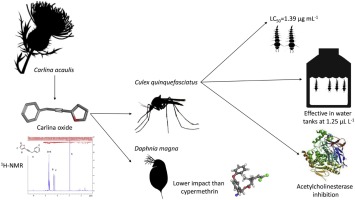Industrial Crops and Products ( IF 5.6 ) Pub Date : 2019-05-22 , DOI: 10.1016/j.indcrop.2019.05.037 Giovanni Benelli , Roman Pavela , Riccardo Petrelli , Franks Kamgang Nzekoue , Loredana Cappellacci , Giulio Lupidi , Luana Quassinti , Massimo Bramucci , Stefania Sut , Stefano Dall’Acqua , Angelo Canale , Filippo Maggi

|
Developing effective larvicides for mosquito control is being challenging due to the quick development of resistance in targeted vectors. Botanical products can help, due to their multiple mechanisms of action coupled with eco-friendly features. Carlina acaulis (Asteraceae) is an Alpine perennial herb used as a traditional remedy and food. Its root essential oil (EO) has antimicrobial and antitrypanosomal properties, and is currently listed among botanicals employable in food supplements. Its insecticidal activity has not been explored so far. Here, after analysing the C. acaulis EO chemical composition by GC–MS and NMR, we detected extremely high larvicidal activity of this EO and its main constituent, carlina oxide, against Culex quinquefasciatus larvae by using the standard WHO protocol. LC50 were 1.31 and 1.39 μg mL-1, respectively. 24-h exposure to both products triggered significant mortality rates for five days post-treatment. Larvicidal tests on a wider scale confirmed >95% larvicidal effectiveness of the EO and carlina oxide tested at 1.25 μg L-1. Their non-target impact was evaluated through experiments on Daphnia magna adults. Both showed significantly lower toxicity if compared to cypermethrin. To shed light on the modes of action, carlina oxide was tested for anti-acetylcholinesterase activity by the Ellman method, with lower performances over galantamine. A moderate antioxidant potential was observed using DPPH and ABTS assays, since it has a role for preserving the shelf-life of herbal-based insecticides. Finally, cytotoxicity on vertebrate cells was noted, testing carlina oxide on human dermis, HCT116 and MDA-MB231 cell lines by MTT assay. Overall, the outstanding toxicity of the tested products make them excellent candidates to develop novel mosquito larvicides for real-world applications.
中文翻译:

来自卡里纳金合欢根精油的卡里纳氧化物可作为有效的蚊虫杀幼虫剂
由于靶向载体中抗药性的快速发展,开发有效的杀幼虫剂来控制蚊子是一项挑战。植物产品可以发挥作用,因为它们具有多种作用机理以及环保功能。Carlina acaulis(菊科)是一种多年生的高山草药,用作传统药物和食品。它的根精油(EO)具有抗微生物和抗胰锥囊性的特性,目前被列为可用于食品补充剂的植物药。迄今为止,尚未对其杀虫活性进行研究。这里,在分析后C. acaulis通过GC-MS和NMR EO化学成分,我们检测到该EO和其主要成分,卡利娜氧化物的极高杀幼虫活性,抗致倦库蚊幼虫使用标准的WHO规程。LC 50分别为1.31和1.39μgmL -1。两种产品在24小时内接触后,在治疗后5天中均导致了很高的死亡率。更大范围的杀幼虫剂试验证实,在1.25μgL -1下测得的EO和氧化卡因的杀幼虫效果> 95%。通过对大型蚤(Daphnia magna)的实验评估了它们的非目标影响成年人。与氯氰菊酯相比,两者均显示出明显更低的毒性。为了阐明作用方式,通过Ellman方法测试了氧化卡琳的抗乙酰胆碱酯酶活性,其性能比加兰他敏低。使用DPPH和ABTS分析法可观察到适度的抗氧化剂潜力,因为它具有保存基于草药的杀虫剂的保质期的作用。最后,注意到了对脊椎动物细胞的细胞毒性,通过MTT法测试了对人真皮,HCT116和MDA-MB231细胞系的氧化卡因。总体而言,被测产品的出色毒性使其成为开发用于实际应用的新型灭蚊幼虫的极佳候选者。






























 京公网安备 11010802027423号
京公网安备 11010802027423号